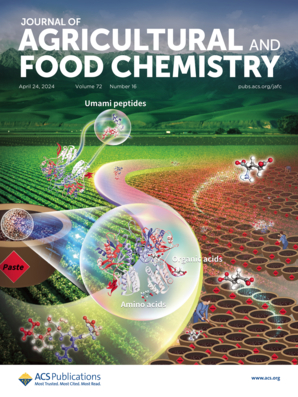利用cnc载体纳米材料增强Zn2+介导的卵菌无性繁殖抑制
IF 5.7
1区 农林科学
Q1 AGRICULTURE, MULTIDISCIPLINARY
引用次数: 0
摘要
卵菌是毁灭性的植物病原体,造成重大作物损失,孢子是主要的感染源。抑制无性生殖,特别是孢子囊的形成和孢子的释放,是预防疾病的关键。Zn2+已显示出抑制卵菌繁殖的潜力,但浓度过高会引起细胞毒性和环境风险。为了解决这个问题,我们使用聚多巴胺(PDA)配合Zn2+,并通过氢键在纤维素纳米晶体(cnc)上形成PDA@Zn2+涂层。该离子纳米农药(CNC@PDA@Zn2+)在减少用量和提高生物安全性的同时,增强了对卵菌的有效性。生物实验结果表明,CNC@PDA@Zn2+通过抑制关键产孢基因(PcATP4、cdc和g蛋白)的表达,破坏孢子细胞膜,改变细胞器结构,显著抑制辣椒疫霉菌(P. capsici)孢子囊形成和孢子释放。在体内,即使有菌丝体存在,它也能减少辣椒叶片上辣椒疫病菌的感染。该研究强调CNC@PDA@Zn2+是一种有前途的生物基纳米材料,可用于可持续作物保护。本文章由计算机程序翻译,如有差异,请以英文原文为准。

Harnessing CNC-Carrier Nanomaterials for Enhanced Zn2+-Mediated Inhibition of Oomycete Asexual Reproduction
Oomycetes are devastating plant pathogens causing major crop losses, with spores as key infection sources. Inhibiting asexual reproduction, especially sporangium formation and spore release, is crucial for disease prevention. Zn2+ has shown potential in inhibiting oomycete reproduction, but excessive concentrations can cause cytotoxicity and environmental risks. To address this, we used polydopamine (PDA) to complex Zn2+ and form a PDA@Zn2+ coating on cellulose nanocrystals (CNCs) through hydrogen bonding. This ionic nanopesticide (CNC@PDA@Zn2+) enhances effectiveness against oomycetes while reducing dosage and improving biosafety. Bioexperimental results indicate that CNC@PDA@Zn2+ significantly inhibits sporangium formation and spore release from Phytophthora capsici (P. capsici) by suppressing the expression of key sporulation genes (PcATP4, cdc, and G-protein), disrupting spore cell membranes, and altering organelle structures. In vivo, it reduces P. capsici infection on pepper leaves, even in the presence of mycelium. This study highlights CNC@PDA@Zn2+ as a promising biobased nanomaterial for sustainable crop protection.
求助全文
通过发布文献求助,成功后即可免费获取论文全文。
去求助
来源期刊
CiteScore
9.90
自引率
8.20%
发文量
1375
审稿时长
2.3 months
期刊介绍:
The Journal of Agricultural and Food Chemistry publishes high-quality, cutting edge original research representing complete studies and research advances dealing with the chemistry and biochemistry of agriculture and food. The Journal also encourages papers with chemistry and/or biochemistry as a major component combined with biological/sensory/nutritional/toxicological evaluation related to agriculture and/or food.

 求助内容:
求助内容: 应助结果提醒方式:
应助结果提醒方式:


